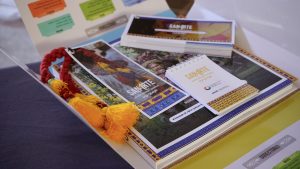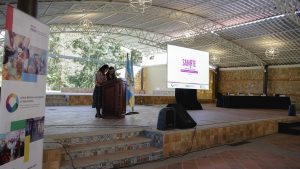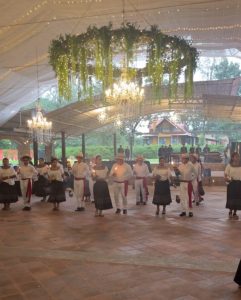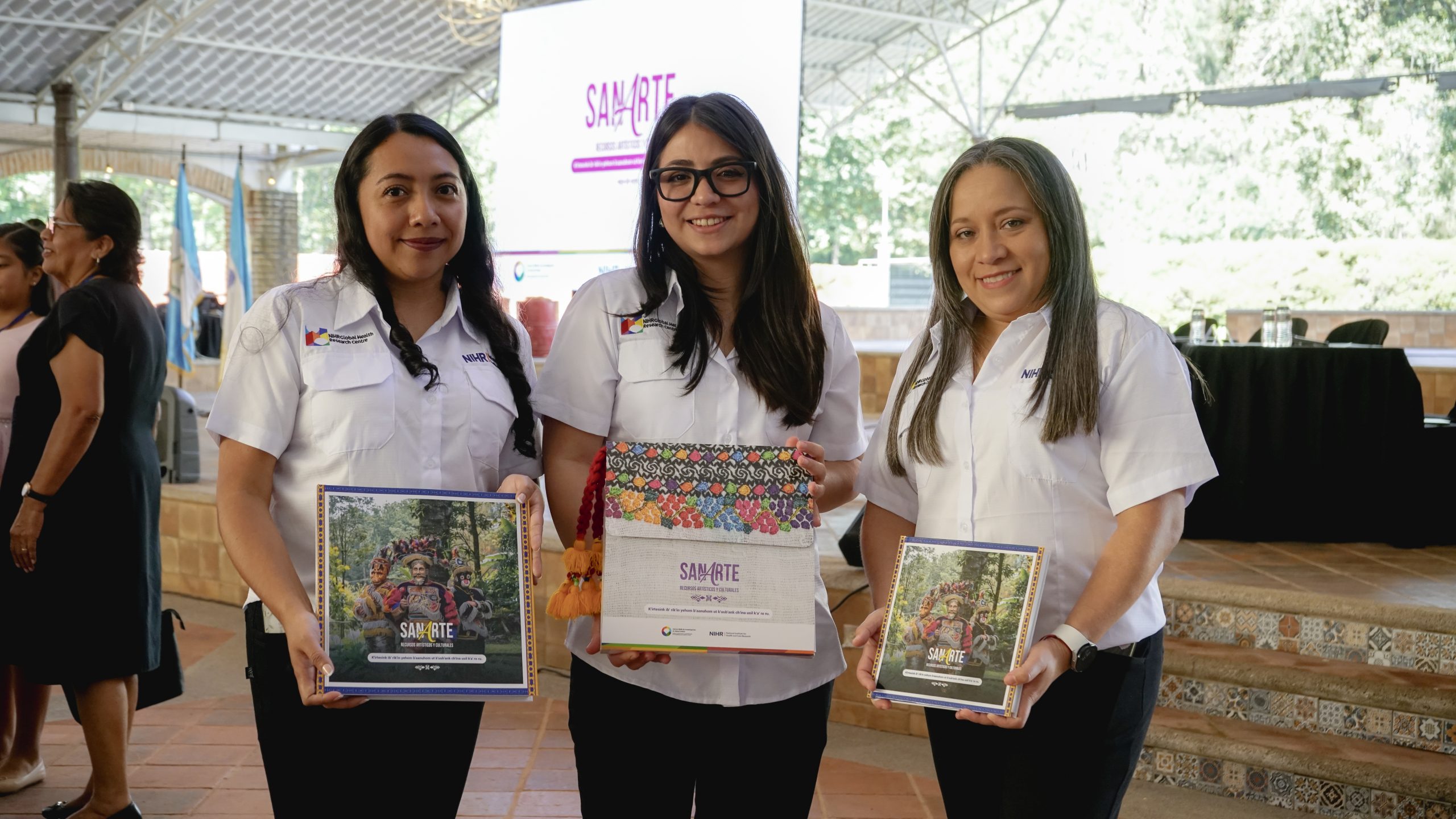 On September 17 in Alta Verapaz, the catalogue SanArte: Artistic and Cultural Resources was officially launched. This publication is the result of a participatory research process led by the NIHR LatAm Centre. University and health authorities, local leaders, and community members witnessed how this tool compiles cultural expressions from San Juan Chamelco and San Pedro Carchá to integrate them into the community-based management of non-communicable diseases (NCDs). In the afternoon, a vibrant Art and Culture Festival brought to life the music, dance, and traditions featured in the catalogue, showing that art is not only documented but also lived. Discover in this article what took place that day, who participated, and why this launch marks a milestone for the future of Guatemala and the region.
On September 17 in Alta Verapaz, the catalogue SanArte: Artistic and Cultural Resources was officially launched. This publication is the result of a participatory research process led by the NIHR LatAm Centre. University and health authorities, local leaders, and community members witnessed how this tool compiles cultural expressions from San Juan Chamelco and San Pedro Carchá to integrate them into the community-based management of non-communicable diseases (NCDs). In the afternoon, a vibrant Art and Culture Festival brought to life the music, dance, and traditions featured in the catalogue, showing that art is not only documented but also lived. Discover in this article what took place that day, who participated, and why this launch marks a milestone for the future of Guatemala and the region.
An international effort by the NIHR LatAm Centre
SanArte is part of a trinational initiative developed in Guatemala, Bolivia, and Colombia. Each country has created its own cultural catalogue using a shared methodology: participatory cultural mapping. Through this approach, the NIHR LatAm Centre seeks to demonstrate how local artistic and cultural resources can support the community management of NCDs.
In San Juan Chamelco and San Pedro Carchá, workshops, community walks, and interviews were carried out with leaders, artists, teachers, and local knowledge holders. Through these activities, practices and expressions such as music, dance, weaving, gastronomy, festivals, and spaces of spirituality were identified and described, reflecting the richness and diversity of the region’s culture. The information gathered was organized into categories and compiled into an accessible catalogue that brings together voices, images, and testimonies from the community. SanArte is a bridge between community knowledge and clinical practice, with the aim that health professionals can recommend cultural activities as a complement to medical treatments.
From research to community
After months of collaborative work with community leaders and knowledge bearers in San Juan Chamelco and San Pedro Carchá, the mapping process culminated in a symbolic moment: the official launch of SanArte: Artistic and Cultural Resources.
The event brought together academic authorities from Universidad Rafael Landívar, representatives of local institutions, members of the NIHR LatAm Centre, community leaders, and media outlets. The presentation marked the publication of a new research resource and opened the conversation on how this catalogue can become a practical tool to integrate art and culture into community-based management of NCDs.
 The launch program began with welcoming remarks from Dr. Juan José Guerrero, Director of the San Pedro Claver Campus of Universidad Rafael Landívar. This was followed by a presentation by Guatemala Manager Lorena Guerrero, who introduced the mission of the NIHR LatAm Centre and its work in the region. This was followed by Magister Daisy Bin’s presentation of the research protocol and methodology that gave life to SanArte. Next, the Principal Investigator for Guatemala and Dean of the Faculty of Health Sciences at URL, Dr. Edgar Miguel López, delivered a speech highlighting the importance of integrating art and culture into the community management of NCDs. Finally, the contents of the SanArte catalogue were presented, showcasing the wealth of cultural and community resources in Alta Verapaz.
The launch program began with welcoming remarks from Dr. Juan José Guerrero, Director of the San Pedro Claver Campus of Universidad Rafael Landívar. This was followed by a presentation by Guatemala Manager Lorena Guerrero, who introduced the mission of the NIHR LatAm Centre and its work in the region. This was followed by Magister Daisy Bin’s presentation of the research protocol and methodology that gave life to SanArte. Next, the Principal Investigator for Guatemala and Dean of the Faculty of Health Sciences at URL, Dr. Edgar Miguel López, delivered a speech highlighting the importance of integrating art and culture into the community management of NCDs. Finally, the contents of the SanArte catalogue were presented, showcasing the wealth of cultural and community resources in Alta Verapaz.
With the catalog launched, the guests and the team gathered at discussion tables to contribute ideas about the future of the catalog, each from their own perspective: the community, the healthcare system, education, or the executive authority. All contributions were highly valuable; it was an enriching and productive activity regarding the overall vision of this research and community endeavor.
Art and Culture Festival
The community as the protagonist
The launch of the catalogue was not limited to the academic event. In the afternoon, the celebration continued with an Art and Culture Festival that brought to life the resources included in SanArte.
 On stage, the San Pedro Carchá Orchestra performed contemporary pieces that moved the audience, followed by Teclas de Hormigo, who delighted everyone with marimba music. Alongside them, the group Los Amigos de la Marimba had children, adolescents, and adults dancing to Guatemala’s national instrument and cultural symbol. The group INED combined music and dance in performances that narrated stories about the community and village life. Emily, a young violinist featured in the catalogue, shared her talent with a moving performance.
On stage, the San Pedro Carchá Orchestra performed contemporary pieces that moved the audience, followed by Teclas de Hormigo, who delighted everyone with marimba music. Alongside them, the group Los Amigos de la Marimba had children, adolescents, and adults dancing to Guatemala’s national instrument and cultural symbol. The group INED combined music and dance in performances that narrated stories about the community and village life. Emily, a young violinist featured in the catalogue, shared her talent with a moving performance.
Around the venue, different areas showcased additional artistic expressions: paintings, prints, and sculptures by local artists and workshops; stands presenting sports and gastronomy resources; and the participation of La Casa de los Caldos, offering tastings of the “Drink of the Gods,” pure unprocessed cacao, along with the traditional shutíos.
The festival closed with Danza en Comunidad, an initiative of the Vice-Rectorate of Identity at Universidad Rafael Landívar. Through this collective dynamic, authorities, community members, cultural resources, and the NIHR LatAm Centre team danced together, reinforcing the sense of community that inspires SanArte.
The launch of SanArte: Artistic and Cultural Resources in San Pedro Carchá was not only the presentation of a catalogue but also a strong step toward new forms of collaboration between communities, local authorities, universities, and the health sector. The event demonstrated that art and culture are more than symbolic expressions: they are living resources that strengthen identity, inspire resilience, and promote wellbeing. With the community’s voice at the center, this catalogue becomes a tool to advance the community-based care of NCDs and, at the same time, a source of pride for Guatemala and the region.

